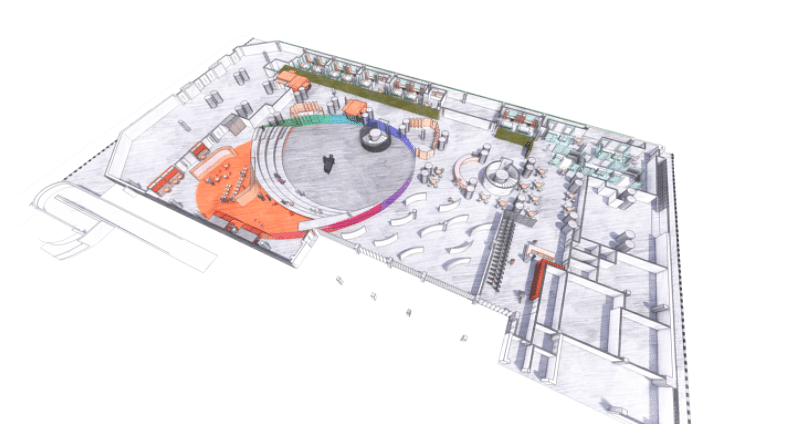The winners of Perkins & Will's 2021 Phil Freelon Design Competition have been announced
By Archinect|
Wednesday, Jun 9, 2021

Related
Architects and designers from multiple Perkins&Will studios worldwide have developed design solutions to address how urban spaces, workplaces, and/or daily life may change in post-COVID London. As part of the firm’s annual Phil Freelon Design Competition, these proposals explore ways parts of London can be transformed into healthier, more sustainable, and inclusive places. Now in its 18th year,
Perkins&Will’s annual internal design competition calls on staff to collaborate and engage in creating innovative design solutions to some of the world’s most pressing issues. The competition was launched in 2004 as the Design Leadership Council Design Competition and renamed in 2019 to honor the eponymous and late architect and Perkins&Will design director who championed design for humanity.
For this year’s competition, design teams were tasked with reimagining one of three existing sites within London, each with a different design scale: urban, building, or interior scale. The urban scale focused on the Culture Mile, a sector for culture and creativity in the heart of London’s financial district. The building scale involves an architectural challenge on a plot within a dense part of the city. The interior scale calls for retrofitting an unused part of the iconic Barbican.
London was chosen as the location for the challenges due to its resilience, having withstanded numerous disasters throughout its nearly 2,000 year history. The COVID-19 pandemic is the most recent event that has plagued the city, coupled with consequential social unrest. Therefore, the competition’s challenge this year was to conceive a design solution that supports holistic well-being and enhances the quality of life for everyone. Entries were judged based on how well they aligned with Perkins&Will’s Living Design framework, a guide by which the firm seeks to create high-performing places that promote human and ecological well-being at every level.
The urban scale submission titled “MUDLARKING: Restoring Riparian Corridors to The City” by Douglas Bergert, Vanessa Eickhoff, Jeremiah Collatz, and Anna Greene won the competition. The vision focuses on reviving ancient waterway systems to create resilient urban environments and diverse living systems within London’s Square Mile. The project proposes the use of river daylighting interventions to replenish the Square Mile by restoring key segments of historic London rivers. This, according to the team, would allow regenerative ecosystems to form and flourish.
The building scale submission, “Lanterns of Hope”, and the interior scale submission, “Convivo” placed second and third place, respectively.

“Lanterns of Hope” by Islam Magdy, Omar ElGarhy, Haguer Samicreates a new mixed-use development to London’s commercial district. The building’s form is inspired by lantern-like cubicles, which are customizable based on varying social, economic, and environmental needs of the community. The complex fosters a busy, communal atmosphere, which promotes sharing, humane qualities, and compassion among residents. It’s a place to meet, organize, and socialize, all while adhering to social distancing and hygiene.

“Convivo” by Dan McNulty, Michelle Heath, Maria Lobit focuses on bringing people from all walks of life together and encouraging interactions at the Barbican. It provides “live, grow and nourish” spaces and a mix of residential, retail, social, educational, laboratory, and activity areas.
The Phil Freelon Design Competition’s jury included, Stirling Prize-winning architect, Amanda Levete, founder and principal of AL_A; design critic and journalist, Jeremy Melvin; Ola Obadara, the Director of the Property Projects Group for the City of London Corporation; and Jeremy Myerson, Helen Hamlyn Professor of Design at the Royal College of Art.
The first-place project was awarded $5,000, with second place, third place, and merit awards are given $3,000, $2,000, and $500, respectively. All proposals for the Phil Freelon Design Competition can be viewed here.

Share
0 Comments
Comment as :